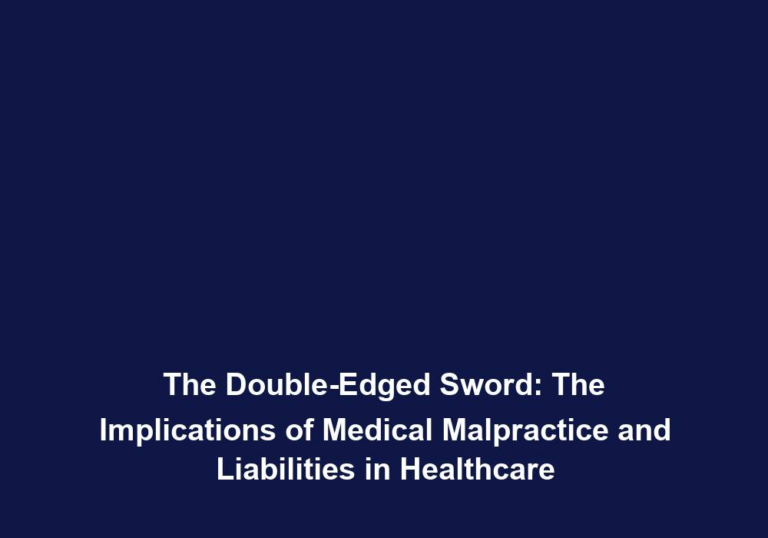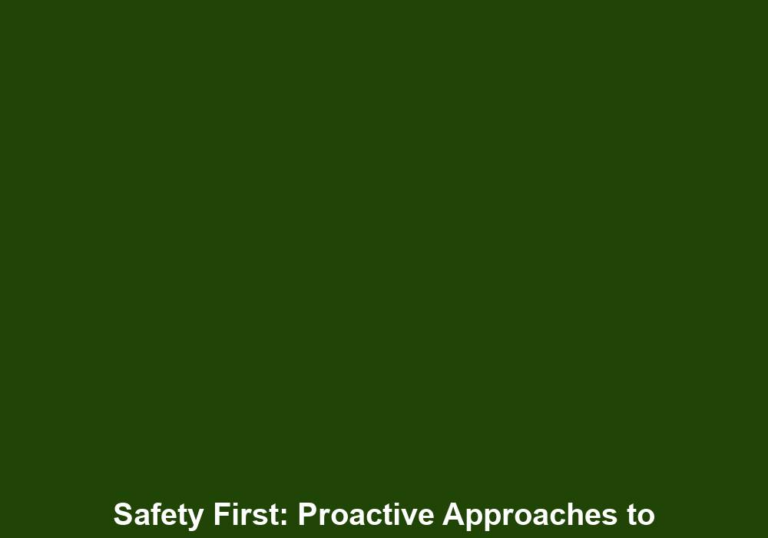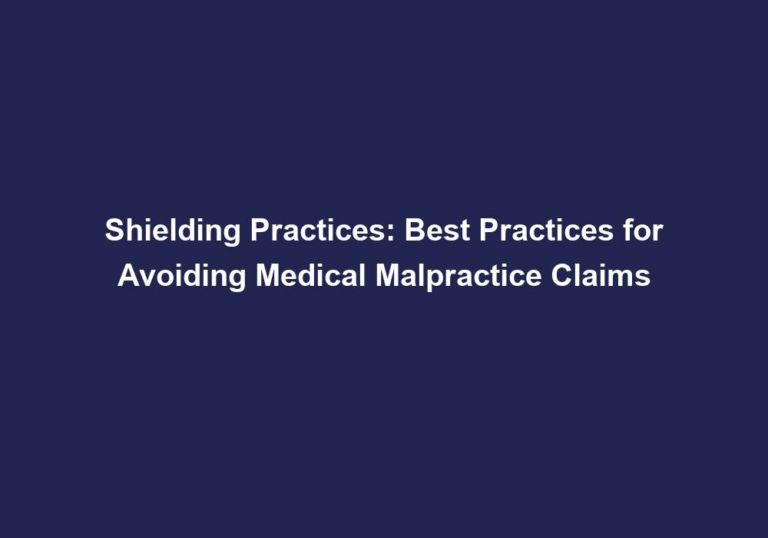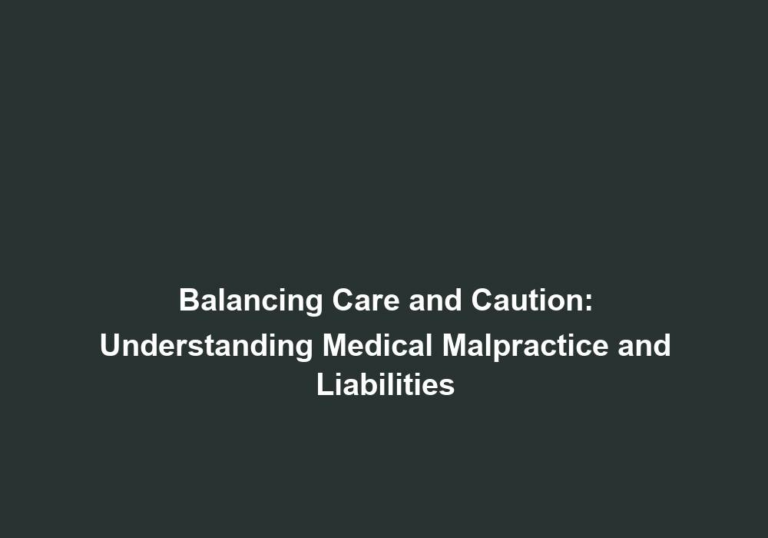Staying Clear of the Pitfalls: Strategies for Avoiding Medical Malpractice
Medical professionals have an ethical and legal responsibility to provide quality care to patients. However, medical malpractice cases continue to pose a significant challenge for both healthcare providers and patients. To ensure the highest standard of care and minimize the risk of medical errors, it is crucial for healthcare professionals to adopt effective strategies for avoiding medical malpractice. In this article, we will explore various approaches and best practices that can help healthcare providers steer clear of the pitfalls of medical malpractice.
Understanding Medical Malpractice
Before delving into the strategies for preventing medical malpractice, it is essential to have a clear understanding of what it entails. Medical malpractice refers to professional negligence by a healthcare provider that results in harm, injury, or death to a patient. It can be caused by various factors, such as misdiagnosis, surgical errors, medication mistakes, failure to obtain informed consent, or inadequate follow-up care.
Medical malpractice can have devastating consequences for patients, leading to physical and emotional trauma, financial burden, and loss of trust in the healthcare system. Therefore, healthcare providers must take proactive measures to prevent such incidents from occurring.
Enhancing Communication and Patient Engagement
- Clear and Open Communication: Establishing effective communication channels with patients is key to avoid errors and build trust. Healthcare providers should ensure that patients have a clear understanding of their medical condition, treatment options, and potential risks involved. Encouraging patients to ask questions and addressing their concerns promptly can help prevent misunderstandings that may lead to malpractice claims.
- Regularly communicate with patients in a language they understand, avoiding medical jargon.
- Use visual aids, such as diagrams or models, to explain complex medical concepts.
- Provide written instructions and educational materials to reinforce verbal communication.
- Informed Consent: Obtaining informed consent from patients is not only a legal requirement but also a vital part of ethical medical practice. Healthcare providers must explain the risks, benefits, and alternatives of any proposed treatment or procedure to ensure that patients can make informed decisions about their healthcare.
- Clearly explain the nature of the procedure or treatment, its purpose, and potential complications.
- Provide patients with written consent forms that outline the information discussed.
- Document the patient’s consent in their medical records.
- Patient Education: Educating patients about their medical conditions, treatment plans, and expected outcomes can empower them to actively participate in their own care. Providing educational materials, clear instructions, and follow-up resources can help patients better understand their responsibilities and reduce the likelihood of errors due to misunderstandings.
- Offer educational resources, such as brochures, videos, or websites, that provide detailed information about the patient’s condition.
- Schedule follow-up appointments to address any questions or concerns that arise after initial consultations.
- Encourage patients to engage in self-care practices and adhere to prescribed treatment plans.
Fostering a Culture of Safety and Continuous Learning
- Adopting Evidence-Based Practices: Utilizing evidence-based guidelines and protocols helps healthcare professionals deliver care based on the latest research and best practices. Staying updated on advancements in medical science and incorporating evidence-based practices into daily routines can minimize the risk of medical errors and improve patient outcomes.
- Stay informed about the latest research findings and clinical guidelines in your field.
- Regularly attend conferences, workshops, and seminars to enhance knowledge and skills.
- Collaborate with colleagues to share best practices and learn from each other’s experiences.
- Implementing Quality Improvement Initiatives: Establishing a systematic approach to quality improvement is vital for identifying and addressing potential areas of patient harm. Regularly reviewing and analyzing adverse events, near misses, and patient feedback can help healthcare organizations detect patterns and implement proactive measures to prevent future errors.
- Conduct regular audits of clinical processes and procedures to identify areas for improvement.
- Encourage staff to report near misses or incidents without fear of reprisal.
- Implement strategies, such as checklists or standardized protocols, to ensure consistency and reduce the likelihood of errors.
- Encouraging Teamwork and Collaboration: Effective teamwork and collaboration among healthcare professionals are essential for providing safe and reliable care. Encouraging open communication, fostering a culture of mutual respect, and promoting interdisciplinary collaboration can lead to better decision-making, improved patient outcomes, and reduced occurrence of medical malpractice.
- Establish multidisciplinary teams to address complex cases and ensure comprehensive care.
- Conduct regular team meetings to facilitate communication and information sharing.
- Encourage a culture of learning from mistakes and sharing lessons learned with colleagues.
Ensuring Competence and Continuing Education
- Continuing Professional Development: Healthcare providers must stay abreast of the latest medical advancements and best practices through continuous education and professional development. Attending conferences, workshops, and seminars, as well as engaging in self-directed learning, can help healthcare professionals enhance their knowledge and skills, reducing the likelihood of medical errors.
- Set aside dedicated time and resources for professional development activities.
- Seek opportunities for specialized training or certifications in areas relevant to your practice.
- Stay informed about changes in regulations or guidelines that may impact your practice.
- Monitoring Performance and Accountability: Regular performance evaluations and assessments are essential to identify any skills gaps or areas requiring improvement. Establishing mechanisms for ongoing monitoring of healthcare professionals’ performance and holding them accountable for maintaining competence can contribute to a safer healthcare environment.
- Implement peer review processes to provide feedback and identify areas for improvement.
- Conduct regular performance evaluations based on established metrics and standards.
- Provide resources and support for professional growth and development.
- Embracing Technology: Adopting and effectively utilizing technology solutions can significantly enhance patient safety and reduce medical errors. Electronic health records (EHRs), computerized physician order entry (CPOE) systems, and decision support tools can improve accuracy, streamline communication, and provide real-time access to critical patient information.
- Implement EHR systems to centralize patient information and facilitate seamless communication between healthcare providers.
- Utilize CPOE systems to reduce medication errors and improve prescription accuracy.
- Explore the use of decision support tools to assist in diagnosis and treatment planning.
Protecting Against Legal Risks
- Maintaining Accurate Documentation: Detailed and accurate documentation is crucial in defending against malpractice claims. Healthcare providers should record all relevant information about patient encounters, including symptoms, diagnoses, treatments, and discussions about informed consent. Timely and thorough documentation can serve as valuable evidence in case of disputes.
- Document all patient interactions, including conversations, examinations, and procedures.
- Ensure that documentation is legible, complete, and includes relevant dates and timestamps.
- Store and organize patient records in a secure and accessible manner.
- Obtaining Professional Liability Insurance: Medical malpractice insurance helps protect healthcare providers against potential financial losses resulting from malpractice claims. It is essential to obtain adequate coverage to ensure that both individuals and healthcare organizations are protected from the potential financial burden associated with legal proceedings.
- Research and compare different insurance providers to find a policy that meets your specific needs.
- Regularly review and update your insurance coverage to account for changes in practice or scope of services.
- Understand the terms and conditions of your policy, including any limitations or exclusions.
Conclusion
By implementing these strategies and best practices, healthcare providers can significantly reduce the occurrence of medical malpractice and safeguard the well-being of their patients. Effective communication, patient engagement, continuous learning, and a commitment to patient safety are key pillars in preventing medical errors. By fostering a culture of safety, maintaining competence, and protecting against legal risks, healthcare professionals can stay clear of the pitfalls associated with medical malpractice, ultimately ensuring better healthcare outcomes for all.







